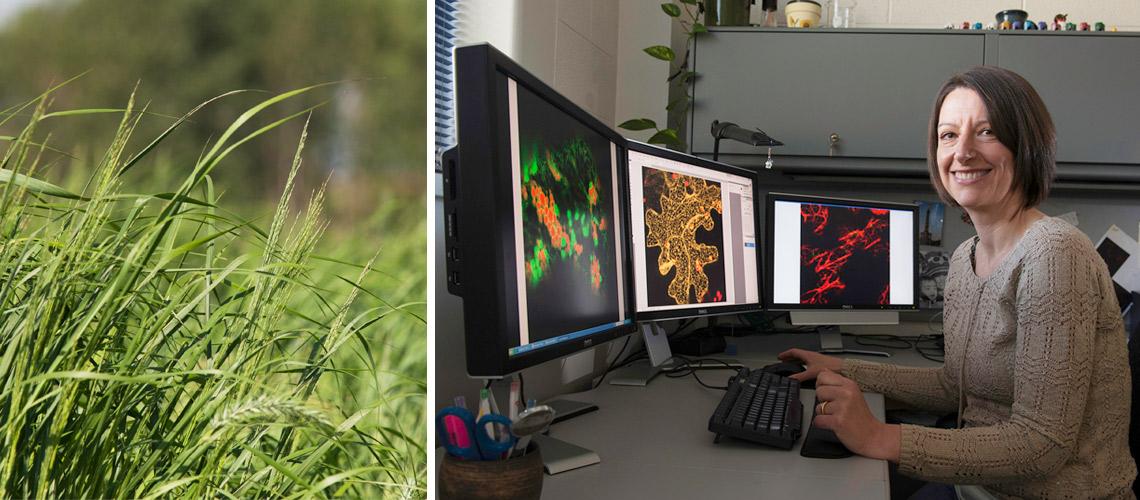
We tend to assume that all botanists have green thumbs. But friends and colleagues stopped giving Federica Brandizzi plants long ago.
“I do have a plant in my office, but my lab is convinced it’s fake,” Brandizzi says. “I don’t think it’s fake, but it is well adapted to drought, let’s put it that way.” Brandizzi, a professor of plant biology at Michigan State University (MSU) and MSU Plants Leader at the Great Lakes Bioenergy Research Center (GLBRC), has been known to break with both stereotypes and family traditions.
Her extended family has been residing in Rome, Italy, for more generations than she can count; so when she left her hometown some 18 years ago to pursue an academic career abroad, that decision was very unusual indeed.
But Brandizzi has not regretted it. At GLBRC, her research on the sugars found in plant cell walls is helping to develop a new pipeline for producing biofuel from cellulosic — or non-food — plant biomass. She was recently named an MSU Foundation Professor, a prestigious honored bestowed upon only a few faculty members.
Brandizzi credits her successful research career to both her parents and her first botany professor at the University of Rome. As a child, her father, a Navy commander, and her mother, an archaeologist and author, instilled in her a desire to ask questions and be curious about the world around her. While gardening was never her passion, she did enjoy growing beans and measuring their leaf and stem sizes.
Years later, watching her college botany professor draw intricate plant structures on the whiteboard got her hooked for life. “I was fascinated by the plasticity and potential of plant cells,” she recalls.
That first professor remained her advisor until she graduated with a Ph.D. from the University of Rome in 1997. A fellowship for a three-month stay in England then turned into a postdoctoral position at Oxford University, which became a springboard for her eventual move to North America.
“Going to England may have been the best thing that ever happened to me,” Brandizzi says. “In Italy, I learned persistence; in England, I learned to take advantage of the latest lab technology. By combining these experiences, I was able to address biological questions from many different perspectives.”
Brandizzi first accepted a faculty position at the University of Saskatchewan in Canada. In 2006, she moved to Michigan State University and soon became an integral part of GLBRC.
Today, her research focuses on hemicellulose, a cell wall component of most plants that consists of various sugar molecules. Yeast and other microbes can convert these sugars into ethanol through a process called fermentation.
But different types of plants vary greatly in the quantity and quality of hemicellulose they produce, and in the mechanism for transporting and storing it. This means a large part of bioenergy research involves figuring out which type of biomass is most suitable to producing ethanol sustainably.
“Our goal is to make as much easily fermentable hemicellulose as possible and store it for a long time without negatively impacting the plant and the environment,” Brandizzi says. “We use advanced microscopy techniques and genetic tools to achieve that goal.”
At the microscope, Brandizzi’s favorite part of the plant cell is the Golgi apparatus, an organelle shaped like a stack of pancakes and named after a fellow Italian scientist.
The Golgi has several important functions: first, it combines simple chemical building blocks into the complex molecules we call hemicellulose; then it puts a plant’s version of giftwrap around these bigger molecules; and finally, it either stores them in the cell wall, or shuffles them to where they are needed.
Brandizzi’s lab recently investigated how the Golgi apparatus of certain grasses assembles a particular cell wall sugar called mixed-linkage glucan (MLG). The answer turned out to be simpler than expected, as only a single enzyme in the Golgi is needed to make MLG.
This finding is significant because yeast can easily convert MLG into ethanol. The GLBRC hopes to develop a new kind of biofuel pipeline by placing this enzyme into grasses or other plants to boost their MLG production without impacting their overall health.
“Our next goal is to study how to maintain high production levels of MLG under environmental stress, such as the extreme temperatures we experience in the Midwest,” Brandizzi says.
Despite her busy research lab, Brandizzi still finds time to honor her Italian heritage by raising three bilingual children and returning to Rome every year to run a marathon. Looking ahead, she thinks the future of biofuels is bright, but does not believe in a single cure-all when it comes to mitigating climate change.
“Since living plants fix carbon, the production and consumption of biofuels can be a self-contained circle,” she says. “That means biofuels have great potential for helping us reduce carbon emissions. But to achieve a more sustainable energy future, they are only one part of a package that requires continued research and investment. I think we should not limit ourselves to pursuing one or two renewable energy technologies alone.”
The GLBRC is one of three Department of Energy Bioenergy Research Centers created to make transformational breakthroughs and build the foundation of new cellulosic biofuels technology. For more information on the GLBRC, visit www.glbrc.org.